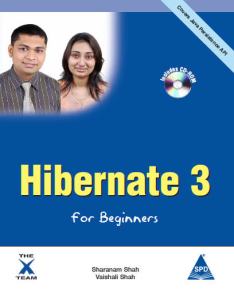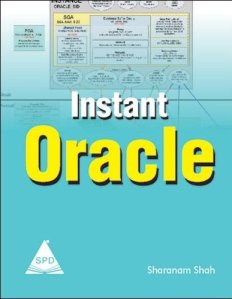
Hibernate 3 For Beginners
Designed for beginners and intermediate developers, this book teaches Hibernate 3 from the ground up with an aim to get the reader up to speed with Hibernate as quickly as possible. It delves deeply into the core of the Hibernate 3 framework, providing a sound understanding of the components that make up the framework and the way they interact with each other.
This book uses the learning by doing pattern with a lot of ready-to-use examples. This pattern has proven to be best approach for beginners. Most [if not all] of the concepts that you will find in this book are demonstrated using well described and easy to understand examples, yet sophisticated enough to demonstrate Hibernate in a real-world context.
Finally, a web based application is developed to re-enforce all the learning that took place throughout the book. Not only this, the book also teaches porting the same application to another database, switching from Hibernate’s native API to Java Persistence API and integrating with Struts2. This will definitely help developers to quickly get started with building real-world Web applications using the Hibernate 3 framework.
ISBN 10: 81-8404-705-3
ISBN 13: 978-81-8404-705-9
Edition: First
THE TOPICS COVERED IN THE BOOK
Introduction
Persistence And Object/Relational Mapping, Introduction To Hibernate
Getting Started
Writing The First Application, Using Hibernate Plugins For NetBeans
Understanding Configuration And Mapping
Configuring Hibernate, Getting Started With Mapping, The Database Identity, Associations, Collections, Concurrency Control Using Versioning, Annotations
Working With Hibernate
Sessions, Transactions, Implementing Connection Pooling
The Hibernate Query Language
The Basics Of Hibernate Query Language, Joins In HQL, The Query Interface, Criteria, Pagination, Named Queries, Native SQL Queries, Filters
Application Development With Hibernate
Customer Database Using JSP, Using Java Persistence API With Hibernate, Customer Database Using Struts2, Switching The Database [MySQL To Oracle]
Appendix
Installing The NetBeans IDE
THE LEARNING THAT TAKES PLACE
Building a web application:
o Using Hibernate 3
o Using Java Persistence API with Hibernate 3
o Using Struts 2 with Hibernate 3
Using the NetBeans IDE to develop Hibernate based applications
Porting an application developed using Hibernate to another database [MySQL to Oracle]
Reverse Engineering POJOs and Mapping Documents from Database Tables
Pagination using Hibernate 3
Connection Pooling using:
o An Application Server [Glassfish] via JNDI
o Hibernate’s built-in mechanism [C3P0]
CONTENTS OF THE CD-ROM
Setup files for JDK 6
NetBeans IDE 6.5
Hibernate Core 3.x
Hibernate Annotations 3.x
Hibernate EntityManager 3.x
Struts 2.x
MySQL Community Server 6.x
Oracle Database 10g XE
JDBC Drivers
Library files for Display Tags
Source code for the examples covered in this book.



![Oracle For Professionals [Covers 9i, 10g, 11g]](https://sharanamshah.files.wordpress.com/2008/09/01_oracleforprofessionals.jpg?w=510&h=292)